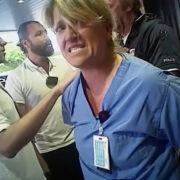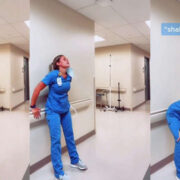Nurses are burnt out on the ER. Responding to medical emergencies exposes nurses to more stress and life-threatening situations than other positions. And lots of ER nurses are looking for a way out. Many are finding work in the cosmetic industry, performing Botox injections at medical spas. The pay is comparable to working in a hospital – minus the emotional baggage.
Aesthetic Nursing
Janet Gedjeyan started working as a bedside nurse in the heart and lung transplant division at a Los Angeles hospital after receiving her nursing degree. She “loved” it at first, but the job didn’t exactly meet her expectations.
“About a year in, I started realizing that patient care was a fraction of what my job entailed,” she said.
Gedjeyan spent most of her time dealing with physicians, social workers, and hospital administrators instead of caring for patients.
Her mother underwent plastic surgery around the same time she was thinking of leaving her job.
“I went with her to her follow-up appointment and the nurse just happened to mention she was ‘doing’ Botox,’” she recalled.
She did some research and found out that registered nurses in California are allowed to perform certain cosmetic procedures, including Botox injections and dermal fillers, as long as they do so “under the direction” of a physician.
“They called it ‘cosmetic nursing,’ ‘aesthetic nursing,’” Gedjeyan explained.
She decided to change careers and hasn’t looked back since. She now works at a “self-care bar” in Southern California doing Botox injections, fillers, and threads. She gained a following on social media as well, including 23,000 followers on Instagram where she goes by the name “Nurse Janet”. Her page features images of her work and tips for performing aesthetic procedures.
According to the American Med Spa Association, over 1,3000 med spas have opened in the U.S. over the last year with an average annual revenue of just under $2 million. They cater to women between the ages of 35 and 54 who want to improve their appearance but aren’t necessarily looking for full-blown plastic surgery. Some want fillers and injections to eliminate the signs of aging, others want to freeze unwanted belly fat or have their body hair removed with a laser.
Economists say the med spa industry tends to be recession-proof. Consumers still want to look beautiful even when prices are high.
“I think people will invest in making themselves look and feel better,” says Terri Ross, a med spa business consultant.
The rise of the med spa industry coincides with the current mass exodus of nurses in the healthcare field. Nurses in traditional healthcare settings have long suffered from anxiety, depression, and even thoughts of suicide. Roughly 34% of nurses say they want to leave their current job by the end of the year; and nurses die by suicide at roughly twice the rate of the general population.
The pandemic has only made things worse, and the staffing shortage shows no signs of slowing down.
Gedjeyan says younger nurses are “picking up on [the fact] that working in a hospital, it’s a lot of burnout from a young age.” And the med spa industry is becoming an increasingly appealing alternative.
Studies show most aesthetic nurses are fleeing hospital positions rather than new nurses who went into the field to practice cosmetology.
Med spas offer added flexibility to nurses that are used to strict work schedules. “I saw a lot of autonomy in it, and I saw a lot of growth in it,” Gedjeyan says.
And nurses can find jobs in the aesthetics field without taking a pay cut. The average yearly salary for aesthetic nurses is around $80,000, on par with the average salary for RNs in hospital settings.
“You have some really big deal injectors doing tons and tons of injections, working their butts off, and earning their money,” says Caroline Barnes, an RN who transitioned from emergency medicine to aesthetic nursing in 2017. But you also have parents who want a three- or four-day workweek and extra time with their kids.
Instead of working for an hourly wage, aesthetic nurses may get paid based on the number of procedures they perform.
Gedjeyan made $104,000 in her first year as an aesthetic nurse, compared to the $74,000 she made in her first year as a bedside nurse. However, she also needs to pay for her own health insurance, retirement plan, and other business expenses. Her employer didn’t disclose her current salary, but Gedjeyan said, “I just knew that if I did well, the money would take care of itself, and the money sure enough did.”
Flexibility and autonomy are often key to reducing burnout. For some nurses, the consultation and beautifying process can also be a creative outlet.
“A lot of people think aesthetics is looking fake or even looking very plasticy, but I think with our training now, aesthetics is just meant to enhance your natural beauty,” says Sabrina Pham, an eyelash tech-turned-RN.
For others, the flexibility gives them the chance to develop their own brand or start a business.
But aesthetic nursing comes with a potential conflict of interest. Nurses need to be a provider first and a salesperson second.
“You’re a clinician first, but you also have to have in the back of your mind, what are some of the things I can do to retain this patient?” says Mimi Martins, a former family medicine physician and owner of Estar MedSpa in Maryland.
But the work can also lead to valuable connections and relationships. “A lot of my relationships are so meaningful,” Pham says of the industry, “and a lot of my patients are my friends, too.”
Not everyone views this kind of work as noble. Cosmetology can come with a negative connotation.
“If I told any of my nursing professors, ‘I’m going into aesthetics,’ they would have found a way to fail me on the spot,” Gedjeyan says.
These skills aren’t taught in nursing school. Providers typically need to pursue additional training to get started in the med spa industry.
“Every nurse injector is different,” Pham says. “I think of it as going to a hair stylist or nail technician; everyone has their own sense of style.”
Nurses also need to be aware of the risks when performing these procedures. Patients can experience allergic reactions and brow ptosis, which causes their eyelids to droop, in response to Botox, vascular occlusion, which is when the blood can no longer pass through the vessel, as a response to fillers, and burns from improper laser hair removal technique. But a skilled aesthetics nurse should be able to stop these complications from happening in the first place.
















